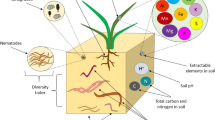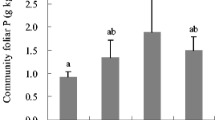Abstract
Aims
Reclamation following oil sands mining in northeastern Alberta (Canada) creates adverse reforestation soil conditions, including extreme pH values. We elucidated pH tolerance limits of boreal plant species and how pH affects nutrient uptake in these plants.
Methods
We measured growth, gas exchange, and foliar nutrient concentration of 15 common northern boreal forest plants after eight weeks exposure to root zone pH ranging from 5.0 to 9.0. Cluster analyses were used to group these species based on their pH responses.
Results
Based on their growth and gas exchange responses to pH, the 15 plant species could be divided into five groups, each of which contained species that commonly co-occur in particular boreal forest site types. For the foliar nutrient responses to pH, the 15 species could be grouped into only two categories; both showed decreases in foliar N, P, Fe and Zn concentration with increasing pH, with a more pronounced effect on the group that included trembling aspen, paper birch and chokecherry.
Conclusions
The evidence of differential adaptation to pH by habitat type suggests the importance of soil pH as a factor affecting boreal plant species distribution and could be helpful for selection of species suitable for reclamation of sites with altered soil pH.






Similar content being viewed by others
References
Audet P, Pinno BD, Thiffault E (2014) Reclamation of boreal forest after oil sands mining: anticipating novel challenges in novel environments. Can J For Res 45:364–371
Beckingham JD, Archibald JH (1996) Field guide to ecosites of northern Alberta. Natural Resources Canada, Canadian Forest Service, northwest region, northern forestry Centre, Edmonton, AB., special report 5
Borcard D, Gillete F, Legendre P (2011) Numerical ecology with R. Springer, New York, p 306
Burns RM, Honkala BH (1990). Silvics of North America, Vol. 2–Hardwoods, Agricultural Handbook 654. Forest Service, Unites States Department of Agriculture, Washington, DC
Calvo-Polanco M, Jones MD, Zwiazek JJ (2009) Effects of pH on NaCl tolerance of American elm (Ulmus Americana) seedlings inoculated with Hebeloma crustuliniforme and Laccaria bicolor. Acta Physiol Plant 3:515–522
Calvo-Polanco M, Senorans J, Zwiazek JJ (2012) Role of adventitious roots in water relations of tamarack (Larix laricina) seedlings exposed to flooding. BMC Plant Biol 12:99–107
Calvo-Polanco M, Equiza MA, Señorans J, Zwiazek JJ (2014) Responses of rat root (Raf.) plants to salinity and pH conditions. J Environ Qual 43:578–586
Comerford NB (2005) Soil factors affecting nutrient bioavailability. In: BassiriRad H (ed) Nutrient acquisition by plants – an ecological perspective. Ecological studies, Vol. 181. Springer, Berlin, pp 1–14
Crawford NM, Glass AD (1998) Molecular and physiological aspects of nitrate uptake in plants. Trends Plant Sci 3:389–395
Epstein E (1972) Mineral nutrition of plants: principles and perspectives. Wiley, New York
Ericsson T (1995) Growth and shoot: root ratio of seedlings in relation to nutrient availability. In: nutrient uptake and cycling in forest ecosystems (pp. 205-214). Springer, Netherlands
Grant J, Dyer S, Woynillowicz D (2008) Fact or fiction: Oil Sands reclamation (p 75). The Pembina Institute, Edmonton
Hayati AA, Proctor MCF (1990) Plant distribution in relation to mineral nutrient availability and uptake on a wet-heath site in south-west England. J Ecol 78:134–151
Hinsinger P, Plassard C, Tang C, Jaillard B (2003) Origins of root-mediated pH changes in the rhizosphere and their responses to environmental constraints: a review. Plant Soil 248:43–59
Howat D (2000) Acceptable salinity, sodicity and pH values for boreal forest reclamation. Alberta environment, environmental sciences division, Edmonton Alberta. Report # ESD/LM/00-2
Iles J (2001) Community trees: community tree steward program. Iowa State University, Ames, Requirements for plant growth. Dept. Horticulture, p 4
Jarrell WM, Beverly RB (1981) The dilution effect in plant nutrition studies. Adv Agron 34:197–224
Jones JB Jr (2001) Laboratory guide for conducting soil tests and plant analysis. CRC Press, Boca Raton
Kallenbach RL, McGraw RL, Beuselinck PR (1996) Soil pH effects on growth and mineral concentration of birdsfoot trefoil. Can J Plant Sci 76:263–267
Kerley SJ, Huyghe C (2001) Comparison of acid and alkaline soil and liquid culture growth systems for studies of shoot and root characteristics of white lupin (Lupinus albus L.) genotypes. Plant Soil 236:275–286
Kerley SJ, Huyghe C (2002) Stress-induced changes in the root architecture of white lupin (Lupinus albus) in response to pH, bicarbonate, and calcium in liquid culture. Ann Appl Biol 141:171–181
Kopittke PM, Menzies NW (2005) Effect of pH on Na induced ca deficiency. Plant Soil 269:119–129. doi:10.1007/s11104-004-0395-0
Larcher W (2003) Physiological plant ecology, 4th edn. Springer-Verlag, Berlin, 450 pp
Lupi C, Morin H, Deslauriers A, Rossi S, Houle D (2013) Role of soil nitrogen for the conifers of the boreal forest: a critical review. Intern J Plant Soil Sci 2:155–189
Macdonald SE, Landhäusser SM, Skousen J, Franklin J, Frouz J, Hall S, Douglass FJ, Quideau S (2015) Forest restoration following surface mining disturbance: challenges and solutions. New Forest 46:703–732
Marschner P (2012) Marschner's mineral nutrition of higher plants. Elsevier Ltd., Waltham
Natural Regions Committee (2006) Natural regions and subregions of Alberta. Compiled by D.J.Downing and W.W. Pettapiece. Government of Alberta. Pub. No. T/852
Perala DA (1990) Populus tremuloides Michx. In: burns RM, Honkala BH (eds). Silvics of North America: volume 2. Hardwoods. Agriculture handbook 654. USDA, Forest Service, Washington, DC
R Core Team (2015) R: a language and environment for statistical computing. R Foundation for Statistical Computing, Vienna, Austria https://www.R-project.org/
Renault S, Paton E, Nilsson G, Zwiazek J, MacKinnon M (1999) Responses of boreal plants to high salinity oil sands tailings water. J Env Qual 28:1957–1962
Shalhevet J, Huck MG, Schroeder BP (1995) Root and shoot growth responses to salinity in maize and soybean. Agron J 87:512–516
Tang C, Longnecker NE, Thomson CJ, Greenway H, Robson AD (1992) Lupin (Lupinus angustifolius L.) and pea (Pisum sativum L.) roots differ in their sensitivity to pH above 6.0. J Plant Physiol 140:715–719
Tang C, Cobley BT, Mokhtara S, Wilson CE, Greenway H (1993) High pH in the nutrient solution impairs water uptake in Lupinus angustifolius L. Plant Soil 155-156:517–519
Tang C, Longnecker NE, Greenway H, Robson AD (1996) Reduced root elongation of Lupinus angustifolius L. by high pH is not due to decreased membrane integrity of cortical cells or low proton production by the roots. Ann Bot 78:409–414
Thormann MN, Szumigalski AR, Bayley SE (1999) Aboveground peat and carbon accumulation potentials along a bog-fen-marsh wetland gradient in southern boreal Alberta, Canada. Wetlands 19:305–317
Yousfi S, Wissal M, Mahmoudi H, Abdelly C, Gharsalli M (2007) Effect of salt on physiological responses of barley to iron deficiency. Plant Physiol Biochem 45:309–314
Zhang W, Zwiazek JJ (2016) Effects of root medium pH on root water transport and apoplastic pH in red-osier dogwood (Cornus sericea) and paper birch (Betula papyrifera) seedlings. Plant Biol 18:1001–1007. doi:10.1111/plb.12483
Zhang W, Calvo-Polanco M, Chen ZC, Zwiazek JJ (2013) Growth and physiological responses of trembling aspen (Populus tremuloides), white spruce (Picea glauca) and tamarack (Larix laricina) seedlings to root zone pH. Plant Soil 373:775–786
Zhang W, Xu F, Zwiazek JJ (2015) Responses of jack pine (Pinus banksiana) seedlings to root zone pH and calcium. Environ Exp Bot 111:32–41
Acknowledgements
We gratefully acknowledge research funding for the study provided through the Syncrude Canada Ltd., Suncor Energy Ltd., Albian Sands Ltd., and NSERC Collaborative Research and Development grants to J.J.Z.
Author information
Authors and Affiliations
Corresponding author
Additional information
Responsible Editor: Michael A. Grusak.
Electronic supplementary material
ESM 1
(DOCX 590 kb)
Rights and permissions
About this article
Cite this article
Calvo-Polanco, M., Zhang, W., Ellen Macdonald, S. et al. Boreal forest plant species responses to pH: ecological interpretation and application to reclamation. Plant Soil 420, 195–208 (2017). https://doi.org/10.1007/s11104-017-3356-0
Received:
Accepted:
Published:
Issue Date:
DOI: https://doi.org/10.1007/s11104-017-3356-0




